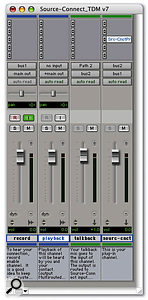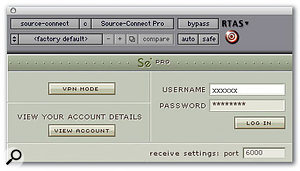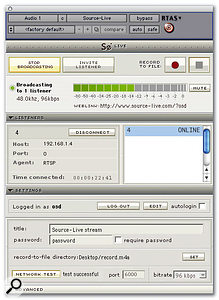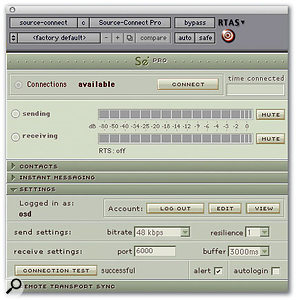An innovative new plug-in allows Pro Tools users to record each other over the Internet, in real time.
Those with a long memory might recall the Rocket Network system for long-distance collaboration. With the Rocket Network, you could have two or more users working on the same project from remote locations via a central server that handled the file management. However, there was no reliance on sending audio in real time over the Internet: when a user added new data to their Session, the Rocket Network would upload that to the other users. The down side was that the others had to wait whilst the system did this. For more details see the Pro Tools Notes in the October 2001 issue of Sound On Sound.
Rocket Network is long gone, but now a different company called Source Elements have come up with a product that enables real-time working across the Internet, enabling you to sync up Pro Tools Sessions in real time across the world — or at least where you have a good broadband Internet connection!
 The template Session supplied by Source Elements illustrating how Source-Connect should be plumbed into a Pro Tools project.So how does it work? Source-Connect is an HTDM/RTAS plug-in which supports all Pro Tools configurations from v6.4 upwards — both TDM and LE, Mac and PC — and is authorised to an iLok key. You also need a broadband Internet connection of some flavour, and Source Elements advise that this needs to have download and upload speeds of at least 300kbps.
The template Session supplied by Source Elements illustrating how Source-Connect should be plumbed into a Pro Tools project.So how does it work? Source-Connect is an HTDM/RTAS plug-in which supports all Pro Tools configurations from v6.4 upwards — both TDM and LE, Mac and PC — and is authorised to an iLok key. You also need a broadband Internet connection of some flavour, and Source Elements advise that this needs to have download and upload speeds of at least 300kbps.
To use Source-Connect you need to add an aux input track to your PT Session, add the Source-Connect plug-in as an insert on that track, then route the audio to and from that track so that, in effect, the aux track becomes your remote I/O interface. It is important to note that the Source-Connect plug-in does not act like other plug-ins, in that audio routed to the input of this channel no longer reaches its output when Source-Connect is inserted. Instead, audio routed to the input of the channel gets sent out over the Internet, and the audio received from the Internet shows up on the output of the channel. Source Elements have a template Session on their web site and the screen, left shows the Mix window of this template Session.
The track at the right-hand end is this I/O interface aux input track. You will see that the output of this track is routed to buss 1, and you should set the input of the track you wish to record your remote audio on to buss 1, as in the Record Track in this example. You also need to route an output from your Session so that your remote user can hear audio from your Session. You will notice in this example that the output routing from the Playback track has a '+' in front of its routing. This indicates that there are further outputs set from this channel, in this case buss 2 as well as 'main out'. (To assign multiple outputs from a track in this way, hold down the Ctrl key as you select an extra output.) Finally, buss 2 should be selected as the input source on the Source-Connect I/O aux track to complete the two-way routing. The other track in the template is an aux track that is there to route the output of a talkback mic to the remote user to enable easy voice communication.
Case Study
Mike Aiton runs the Pro Tools audio suite at ESPN Classic in London, a newly launched sports channel on Sky. ESPN produce programming in four European languages for broadcast on their four separate networks throughout Europe.
One of the applications Mike uses Source-Connect for is to get access to a much wider range of voiceover talent to add foreign-language audio to ESPN's programming. Mike has a 'ring-fenced' 1Mbps up- and download link on the company's 'pipe' to the internet. With this he is able to work at 320kbps both ways, and he says "I can't tell the difference, it is like having the voiceover in my own studio."
One of his regular link-ups is with Zerodibi (pronounced ZeroDB) in Milan, Italy run by Clay Remini. Mike prepares a working Session with three stereo tracks, containing dialogue, sound effects and music. He also produces a guide video track using Avid's Media Station V10 for Pro Tools to digitise the video, from which he produces an MPEG 4 version of the video for the remote studio to view. Next he Zips up the Session and the video files and uploads them to an FTP site. Zerodibi then downloads these files, opens up the Session, adds the necessary Source-Connect tracks from a template Session and they are ready to go.
From within the Source-Connect plug-in, Mike is able to control the transport of Zerodibi's system and the session then becomes just the same as if the talent were in Mike's own vocal booth. The person recording the voiceover is able to see the video and so isn't working 'blind', and both systems lock up in around half a second. Source-Connect has revolutionised the way ESPN handle their foreign-language dubs. Before they would have to send out a producer to Milan, with associate flights and overnight stays. Now they hook up with Milan using Source-Connect and the producer walks down to the dubbing suite, and it is all done in under an hour. "It's like magic!"
The Plug-in Window
The plug-in initially offers a log-in window. All users need to be registered at the Source Elements web site, so the first thing to do is to log in to the Source-Connect server. Once you're logged in, the window expands to show the I/O or Connections section. This section has input and output metering and also indicates the status of your connection.
 Above: The first stage in any remote recording session is to log in.There are four other sections that can be expanded as required.
Above: The first stage in any remote recording session is to log in.There are four other sections that can be expanded as required.
Contacts
This section shows which of your Contacts are on-line and so available to connect to. Contacts are other users you can link up with, and you can use the Source Elements web site to search, add or remove users from your contacts list. Once you have logged on you will then show up as 'on-line' to other users whose contact lists you are in. By clicking on the Profile button you can see another user's details, and once registered you should also create your own Profile, which will help other users looking for someone to link up with.
Instant Messaging
To further assist two-way communication, there is an instant messaging option built into the plug-in window to enable text communication without interfering with the audio paths. Source Elements have added keyboard shortcuts to make it easy to switch between working in the Session and using the instant messaging without using the mouse.
 When you're logged in, Source-Connect will tell you if any of your Contacts are on-line and available for collaboration. Settings
When you're logged in, Source-Connect will tell you if any of your Contacts are on-line and available for collaboration. Settings
This section enables you to set the Send Data Rate and Resilience, which is a send data error-correction setting. It can be set between 0 and 4, with the higher settings better suited to very high bandwidth connections. The Receive settings are Buffer, which is there to help protect against problems due to 'packet loss' and 'jitter' where bits of your data are delayed or don't get to the other end and need to be re-sent, and Port, which specifies the port that needs to be opened in your firewall to enable you to send and receive audio. You do have a firewall, don't you? Source Elements have very comprehensive notes on their web site to assist you in setting up your firewall, and the plug-in does a test to verify that it is all working correctly.
Remote Transport Sync
This is the section that enables you to sync the various Pro Tools Sessions together. It cleverly uses a special version of a Rewire plug-in to achieve this. You control the remote system's timeline position, so when you press the Play button, it is like reaching out to locate the cursor and hit the space bar on the other person's system. Once the remote system is running it tells the host system to chase where it is through the special Rewire plug-in and then the two systems are in sync. Source Elements have included a range of special keyboard shortcuts for this function to keep the Session flowing.
Source-Live
 Another new plug-in from Source Elements allows you to broadcast your mixes live over the Internet in real time for instant client approval. No more FTP uploading and downloading: your clients only need a basic Internet connection, web browser and audio monitoring connected to their computers to be able to review your mixes in real time.
Another new plug-in from Source Elements allows you to broadcast your mixes live over the Internet in real time for instant client approval. No more FTP uploading and downloading: your clients only need a basic Internet connection, web browser and audio monitoring connected to their computers to be able to review your mixes in real time.
It works like this: you put the Source-Live plug-in in your Master track to broadcast the complete mix. Hit the Broadcast button and you will see a URL appear in the plug-in window. Click on the URL to copy it, and either email that URL to your client or click on the Invite Listener button, which will create an email in your default email application with the link already in the text. They put the URL into their browser and there you are, broadcasting directly to multiple clients anywhere in the world. You can set the bit rate according to the available bandwidth of the Internet connections, from 32kbps mono to 320kbps stereo. As the latency with Source-Live is much higher than with Source-Connect, Source-Live is much more tolerant of Internet bandwidth issues and I was successfully broadcasting to New Zealand in a matter of moments even through peak UK Internet usage time.
In The Real World
As you might expect, Source-Connect works best when both parties are working from the same Session, so you would usually want to send the host Session to the remote system via FTP or similar before you begin working (see 'Case Study' box). Source-Connect also needs a good Internet connection and good routing. In fact, Source Elements' recommendation of a minimum of 300kbps up and down rules out nearly all domestic UK broadband Internet connections and most business ones, as the upload speed is usually 256kbps.
 The Settings window allows you to fine-tune the plug-in to work with your particular Internet connection.Users may still find these Internet services work within the UK and Europe, but you will most likely have problems when connecting further afield. However, 8Mbps and faster services are now starting to come on stream in some parts of the country, and these come with faster upload speeds — usually 750kbps, which easily exceeds the 300kbps recommended by Source Elements. Source Elements offer a 15-day free full-featured trial version so you can see if your Internet connection is up it before buying Source-Connect.
The Settings window allows you to fine-tune the plug-in to work with your particular Internet connection.Users may still find these Internet services work within the UK and Europe, but you will most likely have problems when connecting further afield. However, 8Mbps and faster services are now starting to come on stream in some parts of the country, and these come with faster upload speeds — usually 750kbps, which easily exceeds the 300kbps recommended by Source Elements. Source Elements offer a 15-day free full-featured trial version so you can see if your Internet connection is up it before buying Source-Connect.
There are two other bandwidth-related issues that can cause problems. The first is contention ratio. The system employed by broadband service providers means you are actually sharing your connection with as many as 50 other people on a domestic package, so although you might have access to a link that is nominally 8Mbps, your share could be as low as 160kbps, which is no longer fast enough to run Source-Connect. This, of course, is a worst-case scenario as it assumes that all 50 people are on-line and up- or downloading large amounts of data at the same time, which rarely tends to be the case, and this 'diversity' is what the service providers depend on. However, with the increase in media-related services being delivered over the Internet, I believe the diversity issue is going to be an increasing problem until there is a major rebuild of the Internet infrastructure, especially here in the UK. It should be noted that with business packages contention ratios are reduced, often down to 5:1, and that probably explains the price difference between domestic and business broadband services.
The other issue that can affect the performance of the Source-Connect plug-in, or any low-latency real-time Internet application, is 'bottlenecking' which results in packet losses or jitter. This is especially noticeable going across the Atlantic; UK to Europe seems to be fine, but links from the UK to the US and Canada can suffer from these bottlenecks in the Internet infrastructure. Source-Connect is able to handle up to 10 percent packet loss, but above that, it understandably can't cope. In one test with Source-Connect in Chicago I was suffering 30 percent packet loss. This was during peak Internet time on a weekday evening here in the UK, and when I tested the speed of my domestic broadband connection, my download speed was down to around 200kbps although my upload speed wasn't unduly affected.
The Source-Connect software has a good range of settings to cope with a wide range of Internet connections, and as a rule of thumb they suggest a factor of two, meaning that to get 320kbps stereo then you need a solid 640kbps connection. All of this doesn't consider contention ratio, which on domestic circuits is 50:1, so it is a good idea to check your actual upload and download speeds using a site like www.dslreports.com/stest. Even with some business circuits the contention ratio is 5:1, so for it to work reliably, users need a very good pipe to the Internet. This was confirmed by my various tests around the world.
User experiences show that link-ups within Europe are better. It would be fair to say that the effectiveness of the software is very largely controlled by the quality of the Internet infrastructure, and in the UK it is still relatively poor unless you order a large dedicated connection to the Internet like EPSN Classic have done (see 'Case Study' box). With the right sort of Internet connection, however, the plug-in itself just works. It becomes completely transparent and as Mike Aiton says, it is like having the talent in your own studio.
Source-Connect Pro And Source-Connect
With the v2.5 release of the Source-Connect plug-in, Source Elements now offer two options. The Pro version is aimed at studios and post-production houses and offers full access to all the settings, the option to work with a VPN network for very security-minded clients and full access to the Remote Transport Sync option. With the Pro version you can also link up to three remote locations or record six discrete channels from a single location, all simultaneously from within one Session.
The more basic Source-Connect is aimed at remote end users such as musicians and voiceover artists and has a simplified settings panel, limiting the audio bit rate to 192kbps. It will permit the Remote Transport Sync in 'overdub' mode when connected either the Pro or non-Pro version of Source-Connect and will respond to Remote Transport Sync in remote mixing mode when connected to a Pro version.
Pros
- Makes long-distance collaboration easy.
- Very transparent.
- Saves time and money travelling.
Cons
- Needs a very good Internet connection with minimal or no contention ratio.
- Totally dependent on Internet bandwidth and performance.
Summary
If your Internet connection can deliver the bandwidth it needs, Source-Connect is a very neat way of recording remote sources into your Pro Tools Session which becomes almost invisible to the user.

